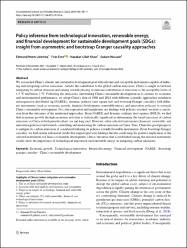| dc.contributor.author | Udemba, Edmund Ntom | |
| dc.contributor.author | Emir, Fırat | |
| dc.contributor.author | Khan, Nazakat-Ullah | |
| dc.contributor.author | Hussain, Sadam | |
| dc.date.accessioned | 2023-10-21T05:35:06Z | |
| dc.date.available | 2023-10-21T05:35:06Z | |
| dc.date.issued | 2022 | en_US |
| dc.identifier.issn | 0944-1344 | |
| dc.identifier.issn | 1614-7499 | |
| dc.identifier.uri | https://hdl.handle.net/11363/5994 | |
| dc.description.abstract | We researched China’s climate and sustainable development goal with relevant and susceptible instruments capable of inducing and mitigating carbon emissions. Amidst the contributor to the global carbon emissions, China is caught in between
mitigating its carbon emission and aiming towards placing its national contribution of emissions to the acceptable levels of
1.5 °C and below 2 °C. Following the intricacies surrounding China’s sustainable development as it contains its economic
and environmental performance, we adopt China’s data of 1980 and 2018 with diferent scientifc approaches (nonlinear
autoregressive distributed lag (NARDL), dynamic ordinary least square test, and bootstrap Granger causality) with diferent instruments (such as economic growth, fnancial development, renewable energy, and innovation policies) to research
China’s sustainable development. For clear exposition and insight into our fndings with policies attached, we draw a conclusion from the outcomes of the mentioned approaches. From NARDL and dynamic ordinary least squares (DOLS), we fnd
that economic growth through economic activities is statistically signifcant in determining the trend (increase) of carbon
emissions in China in both periods (short run and long run). However, other selected instruments (fnancial, renewable, and
innovation policies) tend towards controlling and moderating the carbon emissions in China. Thus, China has good prospects
to mitigate its carbon emissions if considered tailoring its policies towards favorable instruments. From bootstrap Granger
causality, we fnd similar inferential results that support previous fndings thereby confrming the positive implication of the
selected instruments to China’s sustainable development. Hence, the nexus that is established among the selected instruments
clearly show the importance of technological innovation and renewable energy in mitigating carbon emissions. | en_US |
| dc.language.iso | eng | en_US |
| dc.publisher | SPRINGER HEIDELBERG, TIERGARTENSTRASSE 17, D-69121 HEIDELBERG, GERMANY | en_US |
| dc.relation.isversionof | 10.1007/s11356-022-19730-w | en_US |
| dc.rights | info:eu-repo/semantics/openAccess | en_US |
| dc.rights | Attribution-NonCommercial-NoDerivs 3.0 United States | * |
| dc.rights.uri | http://creativecommons.org/licenses/by-nc-nd/3.0/us/ | * |
| dc.subject | Economic growth | en_US |
| dc.subject | Technological innovation | en_US |
| dc.subject | Renewable energy | en_US |
| dc.subject | Financial development | en_US |
| dc.subject | NARDL | en_US |
| dc.subject | Bootstrap granger causality | en_US |
| dc.subject | China’s sustainable development | en_US |
| dc.title | Policy inference from technological innovation, renewable energy, and fnancial development for sustainable development goals (SDGs): insight from asymmetric and bootstrap Granger causality approaches | en_US |
| dc.type | article | en_US |
| dc.relation.ispartof | Environmental Science and Pollution Research | en_US |
| dc.department | İktisadi İdari ve Sosyal Bilimler Fakültesi | en_US |
| dc.authorid | https://orcid.org/0000-0002-6377-3794 | en_US |
| dc.identifier.volume | 29 | en_US |
| dc.identifier.issue | 39 | en_US |
| dc.identifier.startpage | 59104 | en_US |
| dc.identifier.endpage | 59117 | en_US |
| dc.relation.publicationcategory | Makale - Uluslararası Hakemli Dergi - Kurum Öğretim Elemanı | en_US |
| dc.institutionauthor | Udemba, Edmund Ntom | |



















